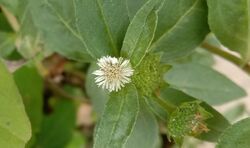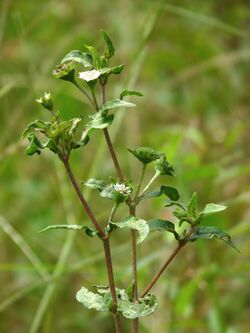Biology:Eclipta prostrata
| Eclipta prostrata | |
|---|---|

| |
| Scientific classification | |
| Kingdom: | Plantae |
| Clade: | Tracheophytes |
| Clade: | Angiosperms |
| Clade: | Eudicots |
| Clade: | Asterids |
| Order: | Asterales |
| Family: | Asteraceae |
| Genus: | Eclipta |
| Species: | E. prostrata
|
| Binomial name | |
| Eclipta prostrata | |
| Synonyms | |
|
Synonymy
| |
Eclipta prostrata, commonly known as false daisy, yerba de tago, guntagalagara aaku, Karisalankanni, and bhringraj, is a species of plant in the family Asteraceae. It is widespread across much of the world.[3][4][5]
This plant has cylindrical, grayish roots. Solid, circular, purplish stems with white fine hairs 0.8m. Leaves arranged in opposite pairs, hairy in two-sided, lanceolate, serrated 2–12.5 cm long, 5-35 mm wide. The solitary flower heads are 6–8 mm (0.24–0.31 in) in diameter, with white florets. The bumpy achenes are compressed and narrowly winged.[6]

This species grows commonly in moist places in warm temperate to tropical areas worldwide. It is widely distributed throughout India , Nepal, China , Thailand, Bangladesh and Brazil .
Traditional uses
The plant has traditional uses in Ayurveda. In India, it is known as bhangra or bhringaraj. Wedelia calendulacea is known by the same names, so the white-flowered E. alba is called white bhangra and the yellow-flowered W. calendulacea is called yellow bhangra.[7]
In Southeast Asia, the dried whole plant is used in traditional medicine,[8] although there is no high-quality clinical research to indicate such uses are effective. The Balinese cook it as a vegetable, the Javanese consume this herb (orang-aring or urang-aring) as part of their lalap, they also infuse it with coconut oil as a kind of hair oil popular until the 1970s[9] Its leaves are extracted as a black hair dye, and in tattooing.[10]
Phytochemistry
Eclipta prostrata contains various phytochemicals, such as coumestans, polypeptides, polyacetylenes, thiophene derivatives, steroids, sterols, triterpenes, and flavonoids.[11]
References
- ↑ Lansdown, R.V.; Beentje, H.J. (2017). "Eclipta prostrata". IUCN Red List of Threatened Species 2017: e.T164051A121894451. doi:10.2305/IUCN.UK.2017-3.RLTS.T164051A121894451.en. https://www.iucnredlist.org/species/164051/121894451. Retrieved 19 November 2021.
- ↑ "Eclipta prostrata (L.) L.". The Plant List version 1.1. http://www.theplantlist.org/tpl1.1/record/gcc-6746.
- ↑ Flora of North America, Eclipta Linnaeus, Mant. Pl. 157, 286. 1771.
- ↑ Flora of China, 鳢肠 li chang Eclipta prostrata (Linnaeus) Linnaeus, Mant. Pl. 2: 286. 1771.
- ↑ Altervista Flora Italiana, Falsa margherita , false daisy, tattoo plant, Eclipta prostrata (L.) L.
- ↑ Steenis, CGGJ van (1981). Flora, untuk sekolah di Indonesia. PT Pradnya Paramita, Jakarta. pp. 423-424
- ↑ Puri, H. S. 2003. Rasayana: Ayurvedic Herbs for Longevity and Rejuvenation. Taylor & Francis, London. pages 80–85.
- ↑ Herbal Medicines Used in Primary Health Care in ASEAN. Department for Development of Thai Traditional and Alternative Medicine. 2014. pp. 148–149. ISBN 9786161122119.
- ↑ Heyne, Karel (1987). Tumbuhan Berguna Indonesia, vol. 3: p. 1833. Yayasan Sarana Wana Jaya, Jakarta
- ↑ Jukema, J., N.Wulijarni-Soetjipto, R.H.M.J. Lemmens & J.W.Hildebrand (1991). Eclipta alba (L.) Hassk. Internet Record from Proseabase. Lemmens, R.H.M.J. and Wulijarni-Soetjipto, N. (Editors). PROSEA (Plant Resources of South-East Asia) Foundation, Bogor, Indonesia
- ↑ Chung, I. M; Rajakumar, G; Lee, J. H; Kim, S. H; Thiruvengadam, M (2017). "Ethnopharmacological uses, phytochemistry, biological activities, and biotechnological applications of Eclipta prostrata". Applied Microbiology and Biotechnology 101 (13): 5247–5257. doi:10.1007/s00253-017-8363-9. PMID 28623383. https://www.hindawi.com/journals/isrn/2014/385969/.
Further reading
- Everitt, J.H.; Lonard, R.L.; Little, C.R. (2007). Weeds in South Texas and Northern Mexico. Lubbock: Texas Tech University Press. ISBN:0-89672-614-2
- Caldecott, Todd (2006). Ayurveda: The Divine Science of Life. Elsevier/Mosby. ISBN 0-7234-3410-7.
External links
- Jepson Manual Treatment, University of California
- United States Department of Agriculture Plants Profile
Wikidata ☰ Q857092 entry
 |





